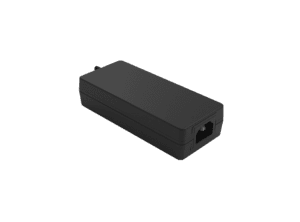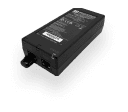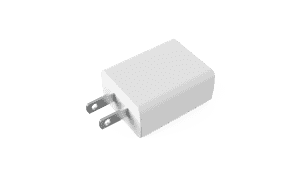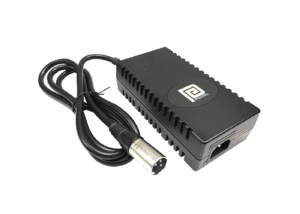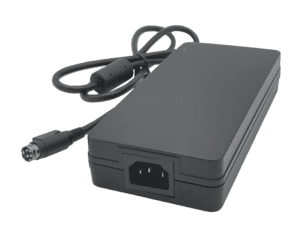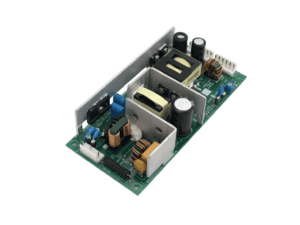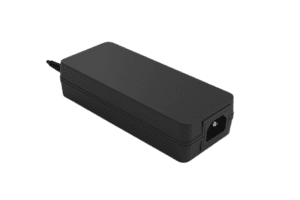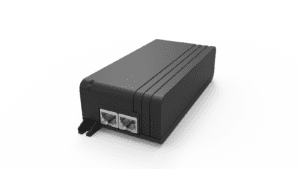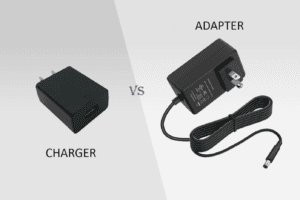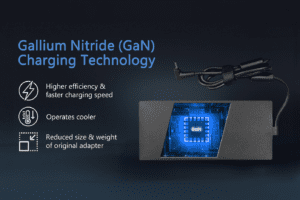BLOG
GaN Power Technology: How to Manufacture High‑Density, Low‑Cost GaN Power Supplies for OEMs
Table of contents

Why Are OEMs Switching to GaN for Power Supply Manufacturing?
Gallium Nitride (GaN) is rapidly becoming the new standard in power electronics. For OEMs, the switch from traditional silicon to GaN technology offers more than just performance gains—it opens up new possibilities in power density, thermal efficiency, and form factor flexibility. As devices get smaller, faster, and more power-hungry, GaN allows OEMs to deliver compact, high-efficiency products at scale.
Unlike silicon, GaN enables higher switching frequencies with reduced heat output, leading to smaller magnetics and fewer thermal management constraints. This translates directly into lighter, thinner, and more efficient designs—critical in sectors like EV, telecom, robotics, and consumer electronics.
Top Features
- Higher Switching Speeds: GaN transistors operate at much faster frequencies than silicon counterparts, enabling miniaturization.
- Improved Thermal Efficiency: Lower heat output reduces the need for bulky heat sinks or airflow management.
- Higher Power Density: Designers can fit more power into a smaller footprint without sacrificing performance.
Top Benefits
- Enables smaller, lighter device designs
- Reduces energy losses, improving system efficiency
- Simplifies thermal and mechanical engineering
Best Practices
- Choose a manufacturing partner with proven GaN experience
- Co-design with your thermal and enclosure constraints in mind
- Validate EMI and thermal performance early using high-speed simulation tools
For OEMs under pressure to deliver next-gen performance in compact packages, GaN isn’t just an upgrade—it’s a competitive advantage.
How Is GaN Power Supply Manufacturing Different from Silicon-Based Production?
While GaN and silicon components may perform similar functions, the approach to manufacturing them—especially for power supplies—is fundamentally different. GaN-based power supplies require advanced layout techniques, custom magnetics, and high-speed switching awareness during PCB design.
Manufacturers must be experienced in dealing with GaN’s unique behaviors, such as gate charge control and layout-induced parasitics, to ensure safe and stable operation. Choosing a manufacturing partner with specific GaN fabrication and testing expertise is critical for avoiding field failures or regulatory issues.
Top Features
- Custom Magnetics and Layouts: GaN’s high-frequency performance demands optimized magnetic designs and PCB routing.
- High-Speed Switching Design Rules: Layout must control parasitics to prevent ringing, overshoot, or EMI failures.
- Thermal Interface Engineering: With fewer heat sinks, thermal pads and material choices are more critical than ever.
Top Benefits
- Improved reliability and safety at high switching speeds
- Faster certification and EMI compliance
- Better integration with compact product housings
Best Practices
- Select a partner with GaN-specific DFM (design for manufacturability) processes
- Conduct joint design reviews focusing on EMI and thermal strategies
- Leverage simulation tools to predict layout-induced switching losses
Building with GaN demands precision. The right manufacturing approach ensures your product reaches performance goals without surprises.
What Are the Cost Benefits of Manufacturing with GaN?
While GaN devices are typically more expensive than silicon on a per-part basis, the overall system cost can actually be lower when engineered correctly. That’s because GaN’s efficiency allows OEMs to reduce size, simplify thermal design, and eliminate redundant components.
For example, a GaN power supply may not require large transformers or bulky heat sinks, leading to savings in materials, packaging, and logistics. Furthermore, high switching speeds allow for smaller passive components and potentially fewer stages in the power conversion process.
Top Features
- Component Reduction: GaN designs often eliminate parts needed for thermal management or voltage regulation.
- Miniaturization Savings: Smaller units reduce packaging and shipping costs across global supply chains.
- Efficiency-Driven Cost Reductions: Higher conversion efficiency results in less power loss and lower operating costs over time.
Top Benefits
- Competitive BOM costs despite higher device prices
- Reduced total cost of ownership over the product lifecycle
- Smaller, more energy-efficient products for end users
Best Practices
- Conduct full cost-modeling during early design stages
- Consider long-term operating cost benefits when pricing your product
- Optimize thermal and mechanical designs to unlock cost-saving opportunities
When analyzed from a systems-level view, GaN can offer significant economic advantages—especially at scale.
CLIENT'S QUOTE
"Phihong’s PoE solutions have made a huge difference for us! Our network runs more efficiently, and we’ve seen real cost savings. We couldn’t be happier!"
How to Overcome Thermal and EMI Challenges in GaN Power Designs
One of the biggest misconceptions about GaN technology is that it runs hotter due to higher switching speeds. In reality, GaN devices produce less heat than silicon when designed properly. However, because they operate so quickly, they introduce new EMI (electromagnetic interference) and parasitic challenges that traditional design teams may not be equipped to handle.
Successfully deploying GaN requires careful layout, shielding, and packaging strategies. Engineers must pay close attention to switching loops, gate drive circuitry, and grounding. Manufacturers experienced in GaN will offer tools and insights that help you manage these challenges without adding cost or bulk.
Top Features
- Optimized Switching Layouts: High-speed PCB routing minimizes EMI, overshoot, and ringing.
- EMI Shielding Techniques: Use of ground planes, ferrite beads, and snubbers where necessary.
- Advanced Thermal Interfaces: Thin-profile materials and copper planes help dissipate heat evenly.
Top Benefits
- Improved safety and thermal reliability
- Easier EMI certification and global compliance
- Cleaner power output for sensitive downstream systems
Best Practices
- Use simulation tools to model thermal and EMI behavior before layout
- Choose a manufacturer with in-house EMI pre-compliance testing
- Validate gate drive stability with real-world switching profiles
GaN’s high performance comes with high precision—when handled correctly, these challenges become manageable advantages.
Key Design Considerations for High-Density GaN Power Supplies
OEMs choose GaN to pack more power into smaller enclosures—but that goal comes with trade-offs. When designing high-density power supplies, every millimeter counts. That means mechanical fit, airflow, and material constraints must be accounted for from the start.
High-density GaN designs demand coordination across teams: power, thermal, mechanical, and regulatory. Manufacturers must optimize layout, integrate protection features, and plan for safe thermal behavior—all while staying within tight volume targets.
Top Features
- Compact Form Factors: GaN enables ultra-slim designs without performance loss.
- Integrated Protections: Built-in OVP, UVLO, and short-circuit protection support miniaturization.
- Flexible Connector and Mounting Options: Designed to fit custom enclosures with minimal wiring.
Top Benefits
- Ideal for portable, wearable, or space-constrained applications
- Reduces risk of thermal failure in small spaces
- Streamlines system-level integration and final assembly
Best Practices
- Share mechanical drawings and airflow constraints early with your power supply partner
- Use modular layouts that can be adapted across product lines
- Balance switching performance with long-term reliability under high power density loads
Designing high-density GaN solutions is about more than component size—it’s about collaboration and strategic engineering choices.
How Phihong USA Supports High-Density GaN Power Supply Manufacturing
Phihong USA brings decades of expertise in power electronics to the forefront of GaN innovation. As OEMs shift toward higher density, more efficient solutions, Phihong delivers custom GaN power supplies built for speed, scalability, and global compliance.
We offer full-spectrum support for GaN-based designs—from concept engineering and rapid prototyping to global manufacturing and regulatory certification. Our engineering teams specialize in EMI mitigation, thermal modeling, and compact mechanical integration, helping OEMs take full advantage of GaN’s capabilities.
At Phihong, we help you:
- Optimize your GaN layout for performance and manufacturability
- Integrate compact thermal and EMI strategies from the start
- Achieve global certifications faster with pre-compliance testing
- Scale from prototype to volume with confidence and supply chain alignment
Whether you’re building for telecom, EVs, consumer electronics, or industrial systems, our GaN manufacturing services accelerate your time-to-market without compromising performance.
Want to learn more?
Schedule a free consultation at www.phihong.com or email us at sales@phihongusa.com. We’re here to help your next GaN-powered product lead the charge.

Contact Our Team Today!
Our dedicated sales team and international partners are prepared to support you with your latest projects and initiatives globally.
Explore More with Phihong USA
As we conclude our exploration of PoE technology, it’s evident how these innovations are streamlining power and data integration across various industries. Phihong USA stands at the forefront of this technological advancement, offering a diverse range of power solutions designed to meet the evolving needs of modern industries.
Phihong USA’s extensive product lineup includes:
- Power over Ethernet (PoE) Solutions: Delivering reliable power and data transmission over a single cable, ideal for simplifying network installations and reducing costs.
- AC/DC Adapters and Power Supplies: From compact adapters to industrial-grade power supplies, Phihong provides solutions that ensure efficiency and reliability in various applications.
- Battery Chargers: Customizable chargers for lithium-ion and lead-acid batteries, supporting a wide range of power requirements for mobility and industrial applications.
- Medical Power Supplies: Specialized power solutions designed to meet the stringent requirements of the healthcare industry, ensuring safety and reliability.
Phihong USA is committed to innovation and excellence, continually developing products that meet the highest standards of performance and reliability. Their global reach and dedication to customer support make them a trusted partner in powering the future.
Here are some useful links to explore Phihong USA’s offerings further and bring in new potential clients:
Visit Phihong USA to discover how their advanced power solutions can support your business needs. Whether you’re looking to upgrade your network, or find reliable power supplies, Phihong USA has you covered.
By choosing Phihong USA, you’re partnering with a leader in power technology, ensuring your operations run smoothly and efficiently with top-tier power solutions. Contact Us today!
FAQ
What is GaN technology and how does it differ from silicon in power supply manufacturing?
GaN, or Gallium Nitride, is a wide bandgap semiconductor that allows power devices to operate at higher voltages, frequencies, and temperatures than traditional silicon-based components. In power supply manufacturing, GaN enables significantly higher switching speeds with lower energy loss, leading to smaller components, better thermal efficiency, and increased power density.
While silicon is more mature and widely available, it has limitations in fast-switching and high-efficiency applications. GaN’s superior electron mobility allows it to handle power conversion more efficiently, which is why it’s quickly becoming the go-to material for next-generation power systems in consumer electronics, EV charging, telecom infrastructure, and beyond.
From a manufacturing perspective, GaN requires different design and layout strategies due to its speed and sensitivity. GaN-based PSUs are typically smaller, lighter, and cooler, making them an ideal choice for OEMs looking to pack more performance into compact devices.
Are GaN power supplies more expensive than silicon? What are the cost trade-offs?
On a component level, yes—GaN devices usually cost more than silicon equivalents. However, when evaluating the total system cost, GaN power supplies can actually be more cost-effective for OEMs. That’s because GaN allows for component reduction, miniaturization, and lower thermal management requirements.
For instance, smaller inductors and capacitors can be used, heat sinks can be downsized or eliminated, and energy efficiency can help reduce system cooling demands. These changes translate into lower material costs, simplified assembly, and reduced packaging and shipping costs.
In addition, GaN’s improved efficiency leads to lower power consumption, which can reduce long-term operating costs—an important benefit for products that run 24/7 or draw high power. For many OEMs, these system-level benefits outweigh the higher price tag of the GaN components themselves.
What design challenges come with GaN power supply manufacturing?
While GaN offers tremendous benefits, it also introduces new challenges in layout, EMI management, and thermal design. GaN devices switch faster than silicon, which can cause EMI issues if PCB layout isn’t optimized. Additionally, their high-frequency performance means parasitic capacitance and inductance must be minimized with precision.
Another challenge is thermal behavior—not because GaN gets hotter, but because it often operates in compact enclosures where heat dissipation becomes a system-level issue. That requires thoughtful thermal interface design, smart material choices, and airflow planning.
To overcome these hurdles, OEMs need a power supply partner experienced in GaN-specific manufacturing techniques, including:
- Advanced PCB layout for high-speed switching
- Thermal modeling and compact heat dissipation
- In-house EMI testing and compliance tuning
When managed correctly, these challenges become manageable and can actually lead to better-performing, more reliable products.
Is GaN suitable for high-power applications like EV chargers or industrial systems?
Yes. GaN is no longer limited to low-power applications like smartphone chargers. Recent advances in GaN technology have made it highly suitable for high-power applications—including EV chargers, telecom infrastructure, robotics, and industrial power modules.
In these use cases, GaN’s efficiency at high voltages and ability to switch faster with less heat offers real advantages over silicon. OEMs can build smaller, lighter, and more energy-efficient power systems that deliver the same or better performance.
The key to using GaN at high power levels is selecting the right device packaging, managing thermal profiles, and working with a partner who understands how to balance power density with long-term reliability. GaN is already being deployed in 6.6kW and even higher-rated systems with great success.
How does Phihong USA help OEMs build GaN power supplies faster and smarter?
Phihong USA helps OEMs harness the full potential of GaN by offering specialized manufacturing services tailored to high-frequency, high-density power supply applications. Our engineers are trained specifically in GaN layout design, EMI mitigation, thermal interface selection, and global compliance—all the areas where GaN differs from traditional power supply builds.
We provide:
- Custom GaN power supply design and prototyping
- Optimized DFM for high-speed switching applications
- In-house EMI, thermal, and safety pre-compliance testing
- Volume manufacturing and supply chain integration for global deployment
Whether you’re building ultra-compact power adapters or high-power EV systems, Phihong supports you from concept to certification. We help reduce design iterations, minimize testing delays, and shorten your overall time-to-market with high-performance, production-ready GaN solutions.
To learn more or get started, reach out to us at sales@phihongusa.com or visit www.phihong.com.

